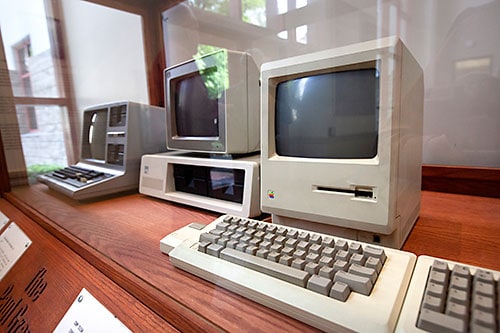CGU is having serious technology flashbacks

Pining for the good old days of tech? Have a hankerin’ for the Altair 8800, maybe a Tandy/Radio Shack TRS-80, or—swoon—a Commodore Amiga with an IBM Thinkpad? If any of this makes sense, congratulations, you’re old.
If not, well, you’re not alone, and Claremont Graduate University’s Paul Gray Personal Computing Museum can help clear up the confusion.
The museum is home to well preserved relics from the early days of the personal computer.
It was founded by the late Paul Gray, a CGU professor since 1983 who helped establish the school’s Center for Information Systems and Technology. Mr. Gray retired in 2001, and although he had no background in museum creation or maintenance, endowed the facility with about 10 early personal computers from his own collection.
Over the ensuing years he continued to accumulate vintage computers from family, friends and colleagues. The museum, at 130 E. Ninth St., Claremont, grew through Mr. Gray’s and a few other CGU colleagues’ hard work and fundraising efforts. Inspired by a PC World story, in 2006 Mr. Gray curated “The 25 Greatest Computers of All Time” exhibit, which included a variety of PCs and peripherals.
The museum was dealt a major blow in 2012 when Mr. Gray was killed in an auto accident at the age of 81. Without its champion, it fell into neglect.
In 2016, Joshua Goode, associate professor of cultural studies and history at CGU, approached Lorne Olfman, the school’s director of the Center for Information Systems and Technology, with an idea. Mr. Goode wanted to involve students in revitalizing the museum, and proposed a course that would invite students to brainstorm ways of reimagining it.
The course was taught during spring 2017, and one of those first students was Kiera Peacock, who ended up being named the museum’s executive director and guiding the revitalization of the displays and didactic materials. Ms. Peacock, who can be seen in a fun CGU Stories video on YouTube, graduated last spring.
“We have out what I think is the most iconic and important for the different stages of personal computing,” Mr. Goode said. “We tried to frame the museum chronologically through the stages of personal computing that existed in our collections.”
At the Gray Museum, one can get a close-up look at fine, working examples of machines long ago relegated to thrift stores and junkyards. You see the hefty plastic and steel cases, retro fonts, floppy discs, and the tiny blinking green monochrome displays in all their low-tech glory.
“It’s kind of fun to take an old ‘luggable’ laptop, which was state of the art at the time, and let a 25 year old pick it up and say, ‘This is what was really light and exciting at the time,’” Mr. Goode said.
And what are his students’ reactions when holding the old tech in their hands? “It’s the weight. It’s the heft. It’s the small size of the displays, the lack of color. It’s not all that different from if you were to open up an icebox and not have a refrigerator. It’s that level.”
There are ambitious one, five and 10 year plans in the works in programming, exhibition and display at the museum.
“We’d love to be able to have some of the machines out so people can work with them,” Mr. Goode said. “Most of them are actually functional. We have a lot of the manuals and software for them as well. And that was important to Paul Gray, that we keep things functional.”
Bringing in school age kids is also something Mr. Goode is keen on.
“We want to think creatively with area schools about the ways in which old technology might be of use to them in their own educational missions or objectives,” he said. “That’s really one of the main goals. We’re a university, and we want people to come and learn, even if it’s just passively walking through, or if it’s bringing student groups.
“And half of those fifth-graders are going to have their own phones in their pockets, and they’re going to see what old personal computing laptop their parents or grandparents were walking around with in the 1990s.”
The museum has many more objects—about two to three times more in storage than are on display, and not just PCs, also printers and displays—most of it in functional condition. The objects it does have out are displayed on two levels in the lobby of the Academic Computing Building.
“Right now we’re happy with the idea of having it be a multi-level museum that people can have contact with as they’re moving through the building,” Mr. Goode said. “I think long term, as the university builds, and we think about expanding, I think we maybe will think about coalescing it into one space.”
And while it may be amusing to poke fun at the museum’s retro content, the truth is the laugh will one day be on us.
Mr. Gray’s vision was to have it be a living thing, documenting technology as it leapfrogs itself. So that means today’s expensive, super-fast, ultra-desirable iWhatever will one day be behind glass at the Gray Museum, with schoolchildren ogling it and giggling at its dated features.
“His mission, and I think his dream for the museum, was knowing the technology would never slow down, and the machines would get smaller and the potential of the interaction between the machine and the individual was going to explode and expand,” Mr. Goode said. “And as these machines got smaller and smaller, he wanted to track that all through the life of the museum.”
The Paul Gray Personal Computing Museum is located in Claremont Graduate University’s Academic Computing Building at 130 E. Ninth St., Claremont. More information is at research.cgu.edu/paul-gray-pc-museum.
—Mick Rhodes
mickrhodes@claremont-courier.com










0 Comments